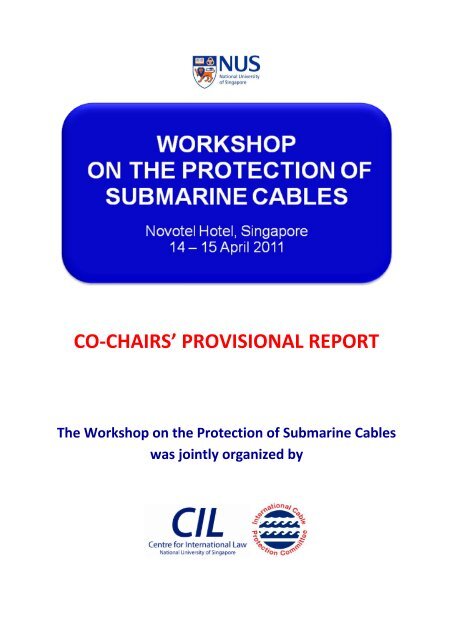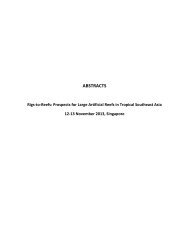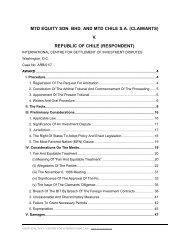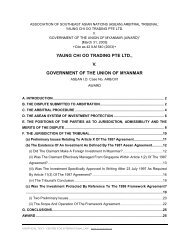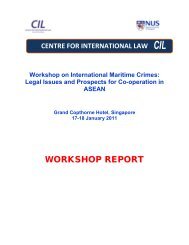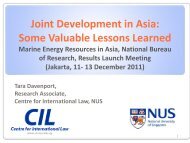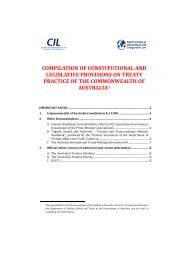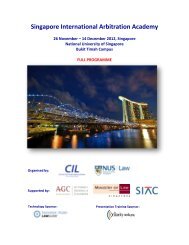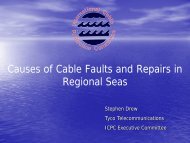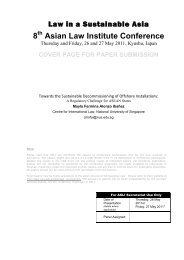Download in PDF format - Centre for International Law
Download in PDF format - Centre for International Law
Download in PDF format - Centre for International Law
Create successful ePaper yourself
Turn your PDF publications into a flip-book with our unique Google optimized e-Paper software.
CO-CHAIRS’ PROVISIONAL REPORT<br />
The Workshop on the Protection of Submar<strong>in</strong>e Cables<br />
was jo<strong>in</strong>tly organized by
BACKGROUND<br />
CO-CHAIRS’ PROVISIONAL REPORT<br />
1. The <strong>Centre</strong> <strong>for</strong> <strong>International</strong> <strong>Law</strong> (CIL) at the National University of S<strong>in</strong>gapore (NUS) and the<br />
<strong>International</strong> Cable Protection Committee (ICPC) jo<strong>in</strong>tly organized a 1 ½ day Workshop on the<br />
Protection of Submar<strong>in</strong>e Cables on 14-15 April 2011 at the Novotel Hotel <strong>in</strong> S<strong>in</strong>gapore. The<br />
Workshop immediately followed the 2011 ICPC Annual Plenary Meet<strong>in</strong>g which was held <strong>in</strong><br />
S<strong>in</strong>gapore from the 12-14 April 2011.<br />
2. The objectives of the Workshop were to <strong>in</strong>crease awareness among Governments <strong>in</strong> the region<br />
about the problems <strong>in</strong> the protection of fibre optic submar<strong>in</strong>e cables (submar<strong>in</strong>e cables) and to<br />
discuss concrete measures that the cable <strong>in</strong>dustry, Governments and <strong>in</strong>ternational<br />
organizations can take to protect submar<strong>in</strong>e cables.<br />
3. The Workshop cont<strong>in</strong>ued the momentum generated by the Workshop on Submar<strong>in</strong>e Cables and<br />
<strong>Law</strong> of the Sea 1 jo<strong>in</strong>tly organized by CIL and ICPC <strong>in</strong> December 2009 and by the General<br />
Assembly Omnibus Resolution on oceans and law of the sea adopted by the UN on 7th<br />
December 2010. The Resolution, <strong>for</strong> the first time, called upon States to take measures to<br />
protect submar<strong>in</strong>e cables which it described as “critical communications <strong>in</strong>frastructure” and as<br />
“vitally important to the global economy and the national security of all States.”<br />
4. The Workshop was co-chaired by CIL Director Robert Beckman and ICPC <strong>in</strong>ternational legal<br />
advisor Douglas Burnett. More than 150 <strong>in</strong>vited representatives from the cable <strong>in</strong>dustry,<br />
Governments, <strong>in</strong>ternational organizations and academia attended the Workshop. Government<br />
participants <strong>in</strong>cluded representatives from 9 of the 10 ASEAN Member States, Ch<strong>in</strong>a, India,<br />
Australia and New Zealand. Representatives from the UN Division on Ocean Affairs and <strong>Law</strong> of<br />
the Sea (UNDOALOS), the <strong>International</strong> Seabed Authority (ISA) and the UN Office of Drugs and<br />
Crime (UNODC) also participated. In addition, more than 80 delegates who had attended the<br />
ICPC Plenary Meet<strong>in</strong>g extended their stay to participate <strong>in</strong> the Workshop.<br />
5. The Workshop Agenda is attached as Appendix 1. The PowerPo<strong>in</strong>t Presentations presented at<br />
the Workshop are available on the CIL Website. 2<br />
SUBMARINE CABLES AS CRITICAL COMMUNICATIONS INFRASTRUCTURE<br />
6. Although many people believe that their emails and phone messages are be<strong>in</strong>g <strong>in</strong>stantly sent<br />
around the world via communications satellites, <strong>in</strong> fact, more than 95% of our electronic<br />
communications are be<strong>in</strong>g transmitted via fibre optic submar<strong>in</strong>e cables laid on the ocean<br />
seabed. In the past quarter-century, there has been an exponential growth <strong>in</strong> submar<strong>in</strong>e cables<br />
<strong>in</strong> response to the communications revolution triggered by the <strong>in</strong>ternet. As a result, almost<br />
every country is heavily reliant on submar<strong>in</strong>e cables <strong>for</strong> almost all electronic communications<br />
1 For more <strong>in</strong><strong><strong>for</strong>mat</strong>ion on the 2009 CIL Workshop on Submar<strong>in</strong>e Cables and <strong>Law</strong> of the Sea, please see<br />
http://cil.nus.edu.sg/programmes-and-activities/past-events/workshop-on-submar<strong>in</strong>e-cables-and-the-law-ofthe-sea-on-14-15-december-2009/<br />
.<br />
2 For PowerPo<strong>in</strong>t Presentations and Papers presented at the Workshop, please refer to<br />
http://cil.nus.edu.sg/powerpo<strong>in</strong>t-presentations-and-papers-presented-at-the-2011-workshop/.<br />
2
elat<strong>in</strong>g to f<strong>in</strong>ance, commerce, air navigation, sea navigation, enterta<strong>in</strong>ment, research and<br />
defence.<br />
7. However, submar<strong>in</strong>e cables are subject to a variety of threats, both natural and man-made.<br />
Natural hazards such as earthquakes, tsunamis and severe storms can cause significant damage<br />
to submar<strong>in</strong>e cables. Man-made causes such as fish<strong>in</strong>g and anchor<strong>in</strong>g activities are also<br />
responsible <strong>for</strong> the majority of submar<strong>in</strong>e cable faults. The damage caused to cables takes a<br />
considerable amount of time to repair, disrupt<strong>in</strong>g telecommunications <strong>for</strong> many States, and<br />
with the average cost of a cable repair rang<strong>in</strong>g between US$ 1-3 million dollars.<br />
THE LEGAL REGIME GOVERNING SUBMARINE CABLES<br />
8. The legal regime govern<strong>in</strong>g submar<strong>in</strong>e cables has its orig<strong>in</strong>s <strong>in</strong> the 1884 Convention on the<br />
Protection of Submar<strong>in</strong>e Telegraph Cables (1884 Convention) which conta<strong>in</strong>ed provisions on the<br />
protection of submar<strong>in</strong>e telegraph cables (the predecessor to fibre optic cables). The 1958<br />
Geneva Conventions on the <strong>Law</strong> of the Sea 3 <strong>in</strong>corporated three provisions on the protection of<br />
submar<strong>in</strong>e cables from the 1884 Convention and also conta<strong>in</strong>ed provisions on the freedom to<br />
lay submar<strong>in</strong>e cables. The 1982 Convention on the <strong>Law</strong> of the Sea (UNCLOS) is the current legal<br />
regime govern<strong>in</strong>g submar<strong>in</strong>e cables and most of its provisions on submar<strong>in</strong>e cables are taken<br />
verbatim from the 1958 Geneva Conventions. For a more detailed discussion on the legal<br />
regime govern<strong>in</strong>g submar<strong>in</strong>e cables, please see the CIL Website. 4 For the 1884 Convention, the<br />
1958 Geneva Conventions and relevant provisions on submar<strong>in</strong>e cables <strong>in</strong> UNCLOS, please refer<br />
to Selected Documents on Submar<strong>in</strong>e Cables available on the CIL Website. 5<br />
PROBLEMS IN LAW AND STATE PRACTICE RELATING TO SUBMARINE CABLES<br />
9. There are four major problems <strong>in</strong> both the law on submar<strong>in</strong>e cables and State practice on<br />
submar<strong>in</strong>e cables.<br />
10. First, many States have not enacted measures to protect submar<strong>in</strong>e cables from compet<strong>in</strong>g<br />
activities both with<strong>in</strong> territorial waters and outside of territorial waters. Neither have they<br />
implemented their obligations under UNCLOS to protect submar<strong>in</strong>e cables. 6 For example,<br />
Article 113 requires States Parties to crim<strong>in</strong>alize the break<strong>in</strong>g or <strong>in</strong>jury of a submar<strong>in</strong>e cable<br />
outside territorial waters done willfully or through culpable negligence by their nationals or by<br />
ships fly<strong>in</strong>g their flag. However, very few States Parties to UNCLOS have passed legislation<br />
implement<strong>in</strong>g this provision.<br />
3 The 1958 Convention on the High Seas and the 1958 Convention on the Cont<strong>in</strong>ental Shelf.<br />
4 See <strong>for</strong> example, Douglas Burnett, “The <strong>International</strong> Legal Regime Govern<strong>in</strong>g the Submar<strong>in</strong>e Cables: UNCLOS<br />
and the 1884 <strong>International</strong> Convention on the Protection of Submar<strong>in</strong>e Cables,” PowerPo<strong>in</strong>t Presentation<br />
presented at the CIL-ICPC Workshop, 14 – 15 April 2011, available at http://cil.nus.edu.sg/powerpo<strong>in</strong>tpresentations-and-papers-presented-at-the-2011-workshop/.<br />
You may also wish to refer to Robert Beckman,<br />
“Submar<strong>in</strong>e Cables Submar<strong>in</strong>e Cables – A Critically Important but Neglected Area of the <strong>Law</strong> of the Sea,”<br />
presented at the 7 th <strong>International</strong> Conference of the <strong>International</strong> Society of <strong>International</strong> <strong>Law</strong> on Legal<br />
Regimes of Sea, Air, Space and Antarctica, 15 – 17 January 2009, New Delhi available at<br />
http://cil.nus.edu.sg/wp/wp-content/uploads/2010/01/Beckman-<strong>PDF</strong>-ISIL-Submar<strong>in</strong>e-Cables-rev-8-Jan-10.pdf<br />
5 This is available at http://cil.nus.edu.sg/wp/wp-content/uploads/2011/02/Submar<strong>in</strong>e-Cables-Documents.pdf.<br />
6 These obligations can be found <strong>in</strong> Article 113, 114 and 115 of UNCLOS.<br />
3
11. Second, there is a need to address the threat posed to submar<strong>in</strong>e cables by <strong>in</strong>ternational<br />
terrorism, which is not adequately covered by the current legal regime govern<strong>in</strong>g submar<strong>in</strong>e<br />
cables as set out <strong>in</strong> UNCLOS. A terrorist attack on submar<strong>in</strong>e cable <strong>in</strong>frastructure could br<strong>in</strong>g the<br />
world’s f<strong>in</strong>ancial markets and transportation systems to a screech<strong>in</strong>g halt <strong>in</strong> a matter of m<strong>in</strong>utes<br />
and can cause billions of dollars of damage. And, if the terrorist attack consisted of cutt<strong>in</strong>g<br />
submar<strong>in</strong>e cables outside the territorial sea limits of any State, there is a reasonably good<br />
chance that such acts would not be a crim<strong>in</strong>al offence under the laws of any State.<br />
12. Third, many States have not adjusted their <strong>in</strong>ternal laws and adm<strong>in</strong>istration to respond to the<br />
fact that submar<strong>in</strong>e cables are critical communications <strong>in</strong>frastructure which they have an<br />
<strong>in</strong>terest <strong>in</strong> protect<strong>in</strong>g. In many States, there is no “lead agency” responsible <strong>for</strong> submar<strong>in</strong>e<br />
cables. As a result, there are no clear policies on submar<strong>in</strong>e cables, and there is no national<br />
legislation to protect submar<strong>in</strong>e cables from either terrorists or from compet<strong>in</strong>g activities such<br />
as fish<strong>in</strong>g and anchor<strong>in</strong>g.<br />
13. Fourth, some States <strong>in</strong> the region have imposed onerous permitt<strong>in</strong>g requirements <strong>for</strong> repairs<br />
which take place <strong>in</strong> territorial waters which can delay repair operations considerably. Similarly,<br />
some States have also imposed unreasonable requirements <strong>for</strong> repairs to cables outside their<br />
territorial waters which are <strong>in</strong>consistent with the legal regime <strong>in</strong> UNCLOS and which also causes<br />
considerable delay <strong>in</strong> repair operations. The problems <strong>in</strong> permitt<strong>in</strong>g requirements are also<br />
complicated by the fact that there is often no lead agency coord<strong>in</strong>at<strong>in</strong>g the repair permitt<strong>in</strong>g<br />
process and cable companies have to apply to many different agencies. Such onerous or<br />
unreasonable permitt<strong>in</strong>g requirements are contrary to the national <strong>in</strong>terests of States,<br />
<strong>in</strong>consistent with UNCLOS (<strong>for</strong> repairs outside of territorial sovereignty) and detrimental to the<br />
<strong>in</strong>terests of other States served by that cable.<br />
RECOMMENDATIONS FOR COOPERATION BETWEEN GOVERNMENTS AND INDUSTRY AT THE<br />
NATIONAL LEVEL<br />
14. All States should appo<strong>in</strong>t a lead agency to coord<strong>in</strong>ate national policy on submar<strong>in</strong>e cables and<br />
coord<strong>in</strong>ate the activities of all relevant Government agencies which deal with submar<strong>in</strong>e cables.<br />
The lead agency should take such measures as are necessary to ensure that all Government<br />
agencies understand the critical importance of submar<strong>in</strong>e cables <strong>for</strong> the economy and security<br />
of the State.<br />
15. The lead agency should be the designated focal po<strong>in</strong>t <strong>for</strong> all policy issues relat<strong>in</strong>g to submar<strong>in</strong>e<br />
cables such as permits <strong>for</strong> lay<strong>in</strong>g and repair of cables, discussions with <strong>in</strong>dustry on proposed<br />
cable routes, etc. In addition, the lead agency should identify the agency who serves as the<br />
contact po<strong>in</strong>t <strong>for</strong> operational and emergency issues relat<strong>in</strong>g to cables, such as the cutt<strong>in</strong>g of a<br />
cable or terrorist threats to cables.<br />
16. The lead agency should establish a dialogue with representatives from <strong>in</strong>dustry to stream-l<strong>in</strong>e<br />
the procedures <strong>for</strong> permits <strong>for</strong> the lay<strong>in</strong>g and repair of cables, etc. The lead agency should also<br />
consult with <strong>in</strong>dustry <strong>in</strong> review<strong>in</strong>g their national laws, regulations and practices on the<br />
protection of submar<strong>in</strong>e cables as well as on the permitt<strong>in</strong>g or notification procedures <strong>for</strong> the<br />
lay<strong>in</strong>g and repair of cables.<br />
4
17. National Governments which currently have no or <strong>in</strong>adequate legislation on submar<strong>in</strong>e cables<br />
should seriously consider us<strong>in</strong>g the legislation of Australia 7 and New Zealand 8 as models <strong>for</strong><br />
their national laws and regulations, <strong>in</strong>clud<strong>in</strong>g the provisions <strong>in</strong> those laws on the establishment<br />
of “cable protection zones” and on mean<strong>in</strong>gful penalties <strong>for</strong> violations which are sufficient to<br />
act as a deterrent. New cable protection legislation should extend protection to <strong>in</strong>ternational<br />
submar<strong>in</strong>e cables used <strong>for</strong> high voltage power as well.<br />
18. For repairs <strong>in</strong> territorial waters, national Governments should work with <strong>in</strong>dustry to develop<br />
“best practices” <strong>for</strong> the grant<strong>in</strong>g of permits <strong>for</strong> the repair of cables which facilitate rapid repair<br />
while at the same time protect<strong>in</strong>g the rights and <strong>in</strong>terests of the coastal State.<br />
19. For repairs outside territorial waters, such as the exclusive economic zone (EEZ) and cont<strong>in</strong>ental<br />
shelf, national Governments and <strong>in</strong>dustry should work together <strong>in</strong> exercis<strong>in</strong>g their “due regard”<br />
obligations, imposed by UNCLOS under the EEZ regime, by establish<strong>in</strong>g “best practices.” This<br />
may <strong>in</strong>clude notice and consultation with respect to the repair of <strong>in</strong>ternational submar<strong>in</strong>e<br />
cables, without requir<strong>in</strong>g cable ships to obta<strong>in</strong> a repair permit or enter port, while at the same<br />
time, recogniz<strong>in</strong>g the sovereign rights of the coastal to explore and exploit the natural resources<br />
on the cont<strong>in</strong>ental shelf and <strong>in</strong> the EEZ.<br />
20. National Governments might consider <strong>in</strong>vit<strong>in</strong>g ICPC and CIL to organize “track two” workshops<br />
at the national level to exchange ideas on how Government and <strong>in</strong>dustry can cooperate with<br />
respect to submar<strong>in</strong>e cables. The cable <strong>in</strong>dustry could consider the creation of Regional Cable<br />
Protection Committees as a way to facilitate such conversations and ideas. 9<br />
21. National Governments which have extensive fish<strong>in</strong>g <strong>in</strong> their territorial waters and EEZ <strong>in</strong> which<br />
destructive fish<strong>in</strong>g techniques are employed might consider <strong>in</strong>vit<strong>in</strong>g ICPC, experts from the<br />
Food and Agriculture Organization (FAO) and the <strong>International</strong> Maritime Organization (IMO) to<br />
study the problem of damage to cables from fish<strong>in</strong>g activities as well <strong>in</strong>terference by fish<strong>in</strong>g<br />
vessels with cable ships engaged <strong>in</strong> cable operations, and recommend the adoption of<br />
regulations or best practices to address the problems.<br />
RECOMMENDATIONS FOR COOPERATION BETWEEN GOVERNMENTS AND INDUSTRY AT THE<br />
REGIONAL LEVEL<br />
22. Governments <strong>in</strong> the region might consider the possibility of establish<strong>in</strong>g a regional body or<br />
network to address issues of common concern relat<strong>in</strong>g to submar<strong>in</strong>e cables or rais<strong>in</strong>g these<br />
issues at exist<strong>in</strong>g regional <strong>for</strong>ums such as the ASEAN Telecommunications Senior Officials<br />
Meet<strong>in</strong>g (ASEAN TEL SOM) and/or the ASEAN Telecommunication Regulators’ Council (ATRC) 10<br />
with appropriate support and/or advice from law of the sea experts <strong>in</strong> Foreign Affairs M<strong>in</strong>istries<br />
or equivalent agencies.<br />
7 Please refer to the Submar<strong>in</strong>e Cables and Pipel<strong>in</strong>es Protection Act 1963 available at<br />
http://www.comlaw.gov.au/Details/C2004C00635 and Schedule 3A to the Telecommunications Act of 1997 at<br />
http://www.austlii.edu.au/au/legis/cth/consol_act/ta1997214/sch3a.html.<br />
8 Please refer to the Submar<strong>in</strong>e Cables and Pipel<strong>in</strong>es Protection Act 1996 available at<br />
http://www.legislation.govt.nz/act/public/1996/0022/latest/DLM375803.html.<br />
9 See Paragraph 23.<br />
10 More <strong>in</strong><strong><strong>for</strong>mat</strong>ion on this can be found at http://www.aseanconnect.gov.my/.<br />
5
23. Cable companies which have commercial <strong>in</strong>terests <strong>in</strong> the region should consider establish<strong>in</strong>g a<br />
Regional Subcommittee of the ICPC or a Regional Cable Protection Committee to <strong>in</strong>terface with<br />
national Governments and any regional body or network established by Governments. This is<br />
because Governments f<strong>in</strong>d it generally easier to deal with a coord<strong>in</strong>ated group represent<strong>in</strong>g the<br />
common <strong>in</strong>terests of the cable <strong>in</strong>dustry rather than <strong>in</strong>dividual cable companies.<br />
24. The Tripartite Technical Experts Group (TTEG) <strong>for</strong> the Straits of Malacca and S<strong>in</strong>gapore might<br />
consider study<strong>in</strong>g the issues regard<strong>in</strong>g damage to submar<strong>in</strong>e cables from the dragg<strong>in</strong>g of ships’<br />
anchors and the m<strong>in</strong>imum distance that other ships should keep from ships engaged <strong>in</strong> cable<br />
lay<strong>in</strong>g and repair operations. If feasible, the TTEG may wish to consider mak<strong>in</strong>g a<br />
recommendation to the IMO <strong>for</strong> the adoption of regulations to prevent such damage. The TTEG<br />
might also consider ensur<strong>in</strong>g that the location of all submar<strong>in</strong>e cables is clearly marked on all<br />
navigational charts, <strong>in</strong>clud<strong>in</strong>g on the Electronic Chart Data In<strong><strong>for</strong>mat</strong>ion System be<strong>in</strong>g employed<br />
<strong>for</strong> the Mar<strong>in</strong>e Electronic Highway <strong>in</strong> the Straits of Malacca and S<strong>in</strong>gapore.<br />
25. Governments <strong>in</strong> the region should consider the possibility of work<strong>in</strong>g with <strong>in</strong>dustry to share<br />
<strong>in</strong><strong><strong>for</strong>mat</strong>ion and develop cont<strong>in</strong>gency plans to address the threat of <strong>in</strong>tentional damage to<br />
<strong>in</strong>ternational cables by terrorists, <strong>in</strong>clud<strong>in</strong>g the establishment of national focal po<strong>in</strong>ts and the<br />
conduct of desk-top exercises and maritime exercises.<br />
RECOMMENDATIONS FOR COOPERATION BETWEEN GOVERNMENTS AND INDUSTRY AT THE<br />
GLOBAL LEVEL<br />
26. Governments <strong>in</strong> the region should consider tak<strong>in</strong>g the lead to br<strong>in</strong>g the gaps <strong>in</strong> the legal regime<br />
to protect cables to the attention of the <strong>in</strong>ternational community, <strong>in</strong>clud<strong>in</strong>g the UN Secretariat<br />
and the ITU, <strong>in</strong> order to enhance awareness and mobilize support to protect submar<strong>in</strong>e cables.<br />
27. Governments <strong>in</strong> the region should work with each other and with the ICPC to br<strong>in</strong>g the gaps <strong>in</strong><br />
the legal regime <strong>for</strong> the protection of cables to the attention of the <strong>in</strong>ternational community at<br />
the UN by propos<strong>in</strong>g paragraphs <strong>for</strong> <strong>in</strong>clusion <strong>in</strong> the omnibus resolution of the UN General<br />
Assembly on Oceans and <strong>Law</strong> of Sea (LOS Omnibus Resolution) and by add<strong>in</strong>g the protection of<br />
submar<strong>in</strong>e cables to the list of issues to be addressed by the Interim Committee of Parties to<br />
UNCLOS.<br />
28. With regard to the protection of cables, States <strong>in</strong> the region should recommend language <strong>in</strong> the<br />
LOS Omnibus Resolution specifically urg<strong>in</strong>g all States to enact new legislation or update exist<strong>in</strong>g<br />
legislation to ensure the implementation of their obligations under Article 113 of UNCLOS.<br />
29. Governments <strong>in</strong> the region should also take the lead <strong>in</strong> propos<strong>in</strong>g the adoption of a new UN<br />
terrorism convention to make it an <strong>in</strong>ternational crime among States Parties to <strong>in</strong>tentionally<br />
destroy or damage <strong>in</strong>ternational submar<strong>in</strong>e cables or submar<strong>in</strong>e cable <strong>in</strong>frastructure.<br />
30. Governments <strong>in</strong> the region should also consider work<strong>in</strong>g together and with the ICPC to <strong>in</strong>itiate<br />
action at the IMO <strong>for</strong> the adoption of measures: (1) to require all ships to keep a def<strong>in</strong>ed<br />
distance from work<strong>in</strong>g cable ships and cable repair buoys and to adopt IMO regulations to this<br />
effect; and (2) to prevent damage to cables from ships’ anchors that are not properly secured<br />
prior to navigation.<br />
6
31. Governments <strong>in</strong> the region and ICPC should also consider br<strong>in</strong>g<strong>in</strong>g the threat to cables from<br />
certa<strong>in</strong> fish<strong>in</strong>g practices such as bottom trawl<strong>in</strong>g to the attention of the FAO.<br />
Robert Beckman, CIL<br />
Douglas Burnett, ICPC<br />
20 April 2011<br />
7
AGENDA<br />
APPENDIX 1<br />
Time: DAY 1:<br />
13:00 – 13:30 Registration <strong>for</strong> Workshop<br />
13:30 – 13:45 Welcome Remarks by Associate Professor Robert BECKMAN, Director of<br />
the <strong>Centre</strong> <strong>for</strong> <strong>International</strong> <strong>Law</strong> (CIL) and Dean VEVERKA, Chairman of<br />
the <strong>International</strong> Cable Protection Committee (ICPC)<br />
13:45 – 15:15 Session 1: Background on Submar<strong>in</strong>e Cables<br />
Chairman:<br />
Associate Professor Robert BECKMAN, Director, CIL<br />
Panelists:<br />
1. Lionel CARTER, Mar<strong>in</strong>e Environmental Advisor, ICPC, Natural Causes<br />
of Cable Faults: Hazard Occurrence, Trends and Case Studies<br />
2. Ian DOUGLAS, Manag<strong>in</strong>g Director, Telecoms, Global Mar<strong>in</strong>e Cable<br />
Systems Ltd. Submar<strong>in</strong>e Cable Faults Caused by Maritime Activities<br />
3. Douglas BURNETT, Legal Advisor, ICPC, The <strong>International</strong> Legal<br />
Regime Govern<strong>in</strong>g Submar<strong>in</strong>e Cables: UNCLOS and the 1884 <strong>International</strong><br />
Convention on the Protection of Submar<strong>in</strong>e Cables<br />
15:15– 15:30 Coffee Break<br />
15:30 – 17:00 Session 2: Repair<strong>in</strong>g Submar<strong>in</strong>e Cables<br />
Chairman:<br />
Douglas BURNETT, Legal Advisor, ICPC<br />
Panelists:<br />
1. Stephen DREW, Mar<strong>in</strong>e Liaison Manager, TE Subcom, Problems faced<br />
by Industry <strong>in</strong> Subsea Cable Repair<br />
2. Associate Professor Robert BECKMAN, Director, CIL, Best National<br />
Practices <strong>for</strong> the Repair of Submar<strong>in</strong>e Cables<br />
3. Alasdair WILKIE, (Hibernia Atlantic) Chairman, UK Cable Protection<br />
Committee (UKCPC), Best Regional Practices: The United K<strong>in</strong>gdom Cable<br />
Protection Committee<br />
4. Claus NIELSEN (TDC), Chairman, Danish Cable Protection Committee<br />
(DKCPC), Best Regional Practices: Submar<strong>in</strong>e Cable Ma<strong>in</strong>tenance by the<br />
Danish Cable Protection Committee<br />
17:00 Close of Day One<br />
17:30 -19:30 ICPC Sponsored Event<br />
Time: DAY 2:<br />
9:00 – 10:30 Session 3: National Solutions <strong>for</strong> the Protection of Submar<strong>in</strong>e Cables<br />
from Compet<strong>in</strong>g Activities<br />
Chairman:<br />
Associate Professor Robert BECKMAN, Director, CIL<br />
8
Panelists:<br />
1. Dean VEVERKA (Southern Cross Cables Limited), Chairman, ICPC,<br />
Shar<strong>in</strong>g the Seabed with Compet<strong>in</strong>g Activities<br />
2. Michael JERKS, Assistant Secretary, Critical Infrastructure Protection<br />
Branch, Attorney-General’s Department and Adam CASON, A/g Senior<br />
Executive <strong>Law</strong>yer, Infrastructure and Digital Economy Services,<br />
Department of Broadband, Communications and the Digital Economy,<br />
Australia, The Australian Government’s Approach to Submar<strong>in</strong>e Cable<br />
Security<br />
3. Mike MCGRATH, Technology Operations Manager, Telecom New<br />
Zealand, Steps taken by the New Zealand Government and Industry to<br />
Protect Submar<strong>in</strong>e Cables<br />
10:30 – 11:00 Coffee Break<br />
11:00 – 12:30 Session 4: Regional Co-operation <strong>for</strong> the Protection of Submar<strong>in</strong>e Cables<br />
from Compet<strong>in</strong>g Activities<br />
Chairman:<br />
Douglas BURNETT, Legal Advisor, ICPC<br />
Panelists:<br />
1. Robert WARGO, (AT&T), President of the North American Submar<strong>in</strong>e<br />
Cable Association (NASCA), The Role of Regional Cable Protection<br />
Committees <strong>in</strong> the Protection of Submar<strong>in</strong>e Cables<br />
2. ANG Joon P<strong>in</strong>g Joshua, Director (Submar<strong>in</strong>e Cables) S<strong>in</strong>gTel, A New<br />
Regional Cable Protection Committee<br />
3. Adam CASON, Senior Executive <strong>Law</strong>yer, Infrastructure and Digital<br />
Economy Services, Department of Broadband, Communications and<br />
the Digital Economy, Australia, The Work of APEC TEL<br />
12:30 – 14:00 Lunch<br />
14:00 – 15:00 Session 5: Global Action <strong>for</strong> the Protection of Submar<strong>in</strong>e Cables from<br />
Compet<strong>in</strong>g Activities<br />
Chairman:<br />
Associate Professor Robert BECKMAN, Director, CIL<br />
Panelists:<br />
1. Mick GREEN, (British Telecom) Vice-Chairman, ICPC, Us<strong>in</strong>g IMO Rules<br />
and Regulations to Protect Submar<strong>in</strong>e Cables<br />
2. Ahmad NORDIN B<strong>in</strong> Ibrahim, Pr<strong>in</strong>cipal Assistant Director, Mar<strong>in</strong>e<br />
Department, Malaysia, The IMO and Anchor Damage <strong>in</strong> the S<strong>in</strong>gapore<br />
Straits<br />
3. James A. R. MCFARLANE, Head, Office of Resources and<br />
Environmental Monitor<strong>in</strong>g, <strong>International</strong> Seabed Authority, The ISA,<br />
ICPC and Submar<strong>in</strong>e Cables<br />
15:00 – 16:00 Session 6: Global Action <strong>for</strong> the Protection of Submar<strong>in</strong>e Cables from<br />
Terrorism and Piracy<br />
Chairman:<br />
9
Douglas BURNETT, Legal Advisor, ICPC<br />
Panelists:<br />
1. Associate Professor Robert BECKMAN, Director, CIL, Terrorism, Piracy<br />
and the Protection of Submar<strong>in</strong>e Cables<br />
2. Vipon KITITASNASORCHAI, Counter Terrorism Officer, UN Office on<br />
Drugs and Crime (UNODC) Regional <strong>Centre</strong> <strong>for</strong> East Asia and the<br />
Pacific, <strong>International</strong> <strong>Law</strong> on Counter-Terrorism and the Protection of<br />
Submar<strong>in</strong>e Cables<br />
3. Serguei TARASSENKO, Director, UN Division <strong>for</strong> Ocean Affairs and<br />
<strong>Law</strong> of the Sea (UNDOALOS), Protection of Submar<strong>in</strong>e Cables: The Role<br />
of the United Nations<br />
16:00 – 16:30 Coffee Break<br />
16:30 – 18:00 Session 7: The Way Forward – (No Presentations)<br />
Chairman:<br />
Associate Professor Robert BECKMAN, Director, CIL<br />
Panelists:<br />
1. Daren TANG, Senior State Counsel, <strong>International</strong> Affairs Division,<br />
Attorney-General’s Chambers, S<strong>in</strong>gapore<br />
2. Mr ONG Tong San, Director (Competition & Market Access), Infocomm<br />
Development Authority, S<strong>in</strong>gapore (IDA)<br />
4. Michael JERKS, Assistant Secretary, Critical Infrastructure Protection<br />
Branch, Attorney-General’s Department, Australia<br />
5. Serguei TARASSENKO, Director, UN Division <strong>for</strong> Ocean Affairs and<br />
<strong>Law</strong> of the Sea (UNDOALOS)<br />
6. Douglas BURNETT, Legal Advisor, ICPC<br />
18:00 Close of Workshop<br />
10


